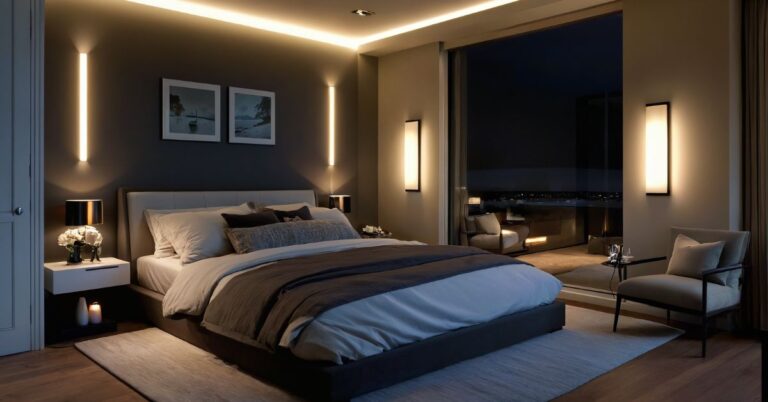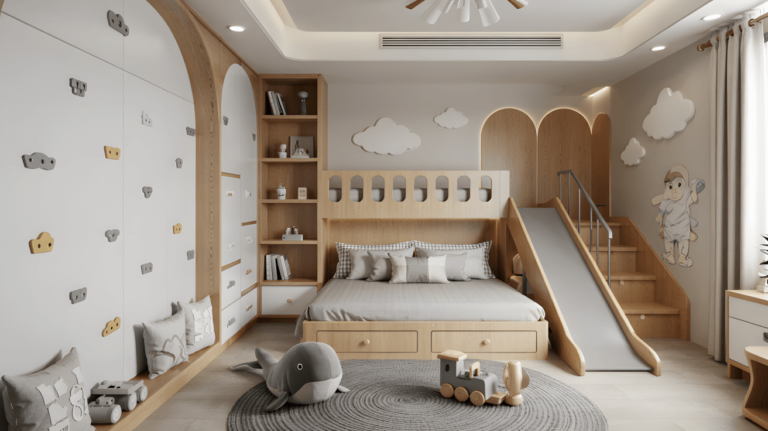Transform your child’s bedroom into a magical sanctuary that makes “lights out” the highlight of their day
The Bedtime Battle Ends Here: Creating Spaces Kids Actually Want to Sleep In
Picture this: It’s 8 PM, and instead of the usual negotiations, tears, and twenty trips back to their room, your child is actually excited to head to bed.
They’re practically racing up the stairs, eager to spend time in their transformed bedroom sanctuary.
This isn’t just a parent’s fantasy—it’s entirely achievable with the right bedroom design approach.
After working with hundreds of families over the past decade as an interior designer specializing in children’s spaces, I’ve discovered that the secret isn’t just about pretty décor.
It’s about creating an environment that feels like a personal retreat, a place where imagination thrives and comfort reigns supreme.
The traditional approach to kids’ bedrooms often misses the mark. We focus on what looks cute to adults rather than what actually appeals to children’s psychological needs for security, creativity, and ownership of their space.
When children feel genuinely connected to their bedroom environment, bedtime transforms from a daily struggle into an anticipated adventure.
In this comprehensive guide, you’ll discover 23 innovative bedroom ideas that go far beyond typical design advice. These aren’t just aesthetic upgrades—they’re strategic transformations that address common bedtime challenges while nurturing your child’s development.
From sensory-rich hideaways to interactive learning zones, each idea is designed to make your child’s bedroom their absolute favorite place to be.
Magical Hideaways: Creating Cozy Retreats Within the Room
1. The Reading Nook Castle
Transform an unused corner into a fairy-tale reading retreat using flowing curtains, soft cushions, and warm string lights. The key is creating clear boundaries that make the space feel separate and special. I recommend using a tension rod system with blackout curtains that children can open and close themselves, giving them control over their cozy environment.
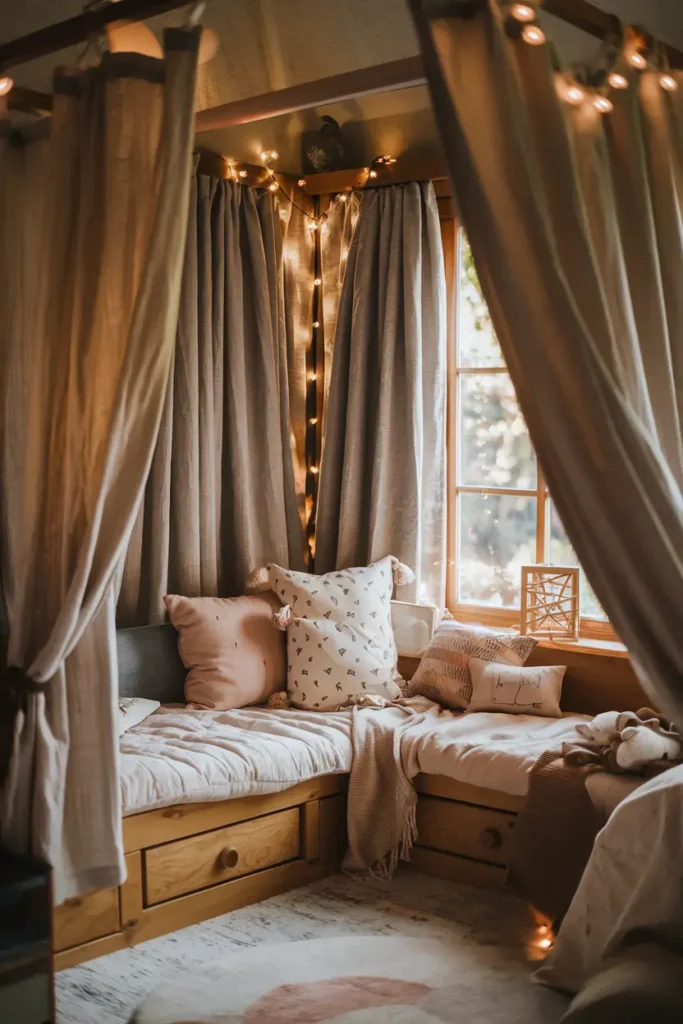
Best for: Children ages 4-12 who love stories and quiet activities
Pro tip: Include a small bookshelf at child height and a basket for their current favorites. The autonomy of choosing their bedtime story makes the routine feel less imposed and more self-directed.
Consider this: Some children find enclosed spaces claustrophobic, so test the concept with blankets first before investing in permanent fixtures.
2. Under-Bed Adventure Cave
Convert the space beneath a loft or bunk bed into an exploration headquarters complete with maps, camping gear, and soft lighting. Use removable wall decals to create cave paintings or treasure maps, making the space feel like a discovery zone.
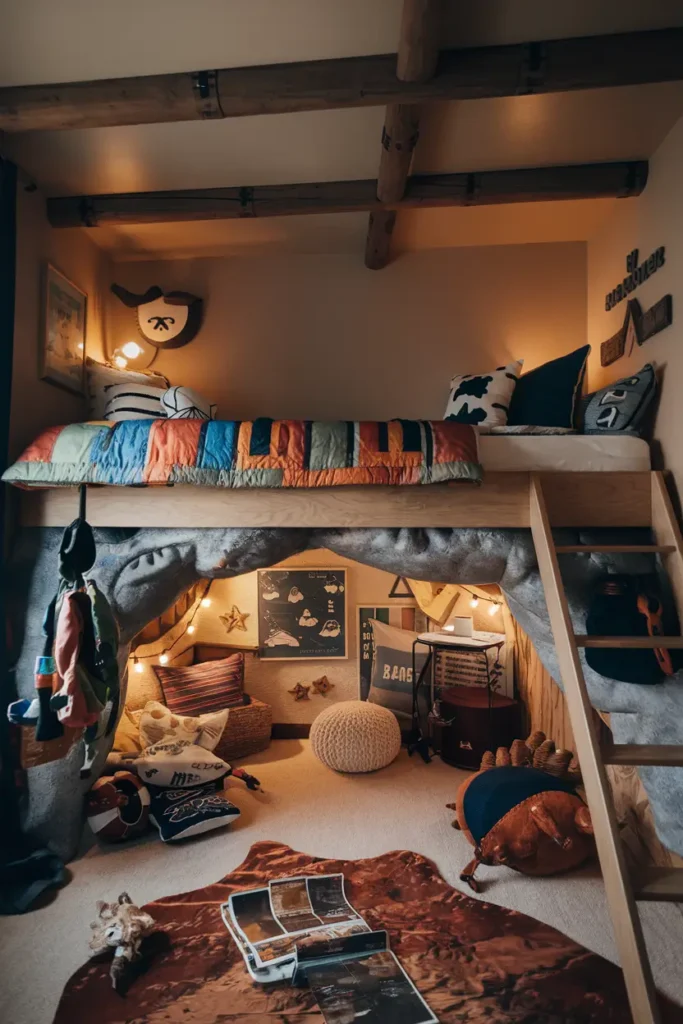
Best for: Active children who need help transitioning from high-energy play to calm bedtime
Pro tip: Install battery-operated LED strip lights with a timer function. They’ll automatically dim and turn off, helping establish a natural wind-down routine without parental intervention.
Consider this: Ensure adequate ventilation and regularly check that the space remains clean and organized to prevent it from becoming overwhelming.
3. Canopy Dreams
A well-designed bed canopy creates an instant sense of enclosure and security. Unlike traditional heavy fabrics, opt for lightweight, breathable materials that create ambiance without feeling stuffy. Mosquito netting works beautifully and comes in various colors.
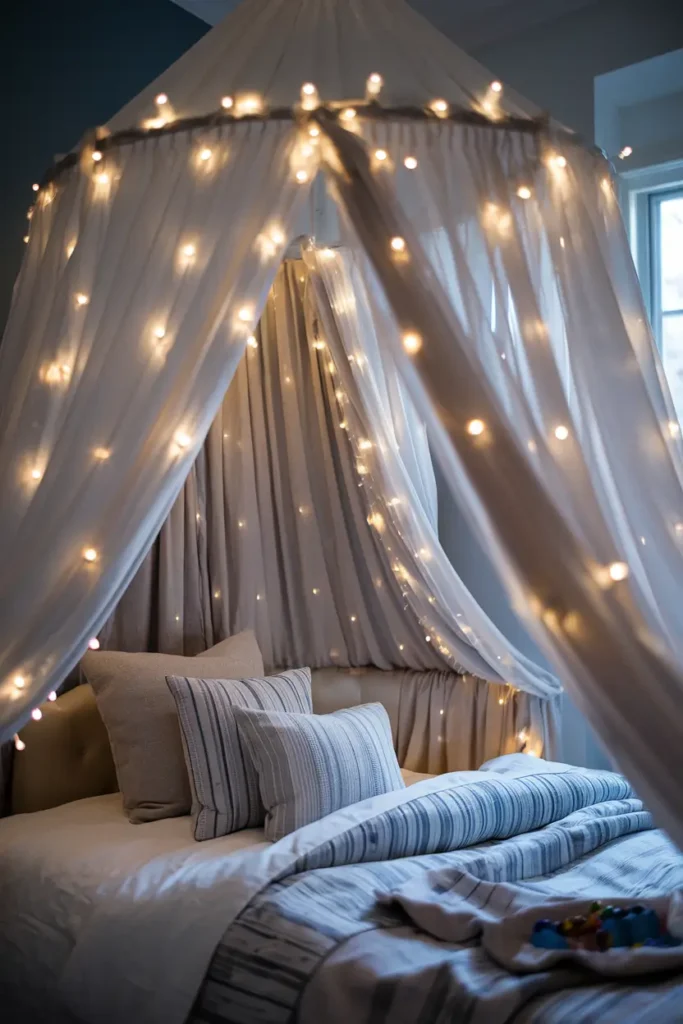
Best for: Children who have trouble settling down or feel anxious at bedtime
Pro tip: Attach small, battery-operated fairy lights to the canopy frame for a magical glow that gradually fades as they fall asleep.
Consider this: Regularly wash fabric elements to maintain hygiene and prevent dust accumulation that could affect sleep quality.
Interactive Learning Zones That Double as Bedtime Entertainment
4. Constellation Ceiling Theater
Install fiber optic lights or high-quality glow-in-the-dark stars to recreate actual constellation patterns on the ceiling. This isn’t just random star placement—use astronomy apps to create accurate star maps that change with the seasons.
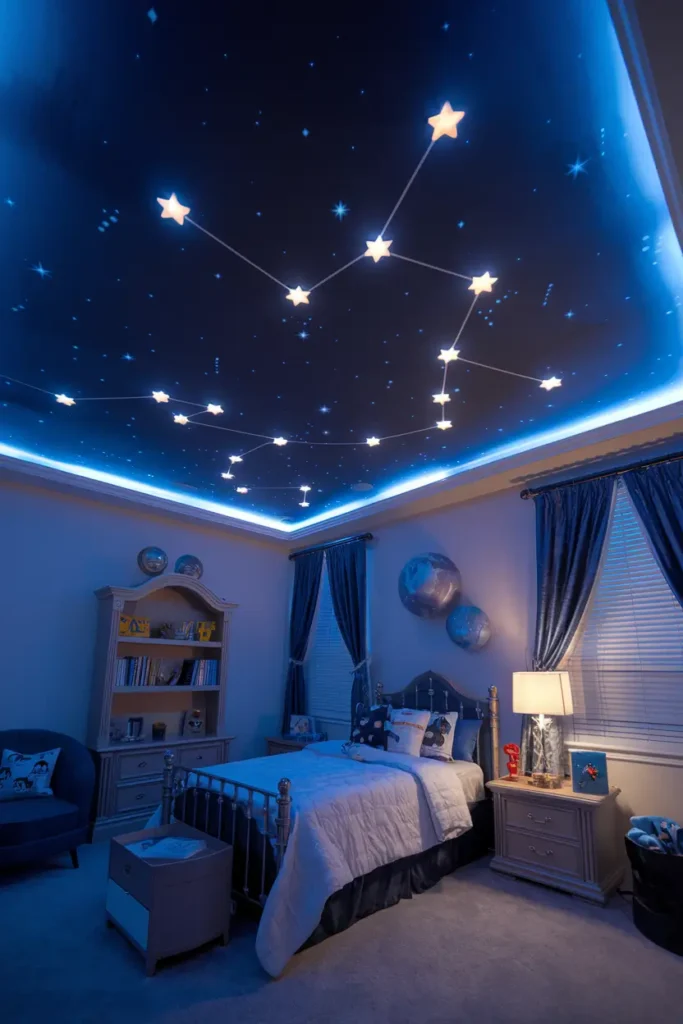
Best for: Curious minds aged 6+ who love science and space
Pro tip: Include a red-filtered flashlight for stargazing without disrupting night vision, and create simple constellation cards they can reference from bed.
Consider this: Invest in quality materials that won’t peel or fade over time, as cheap glow-in-the-dark stickers often disappoint after a few weeks.
5. Wall-Mounted Activity Station
Create a bedside activity center using magnetic boards, small shelves, and rotating displays. Think of it as a quiet entertainment system that doesn’t require getting out of bed.
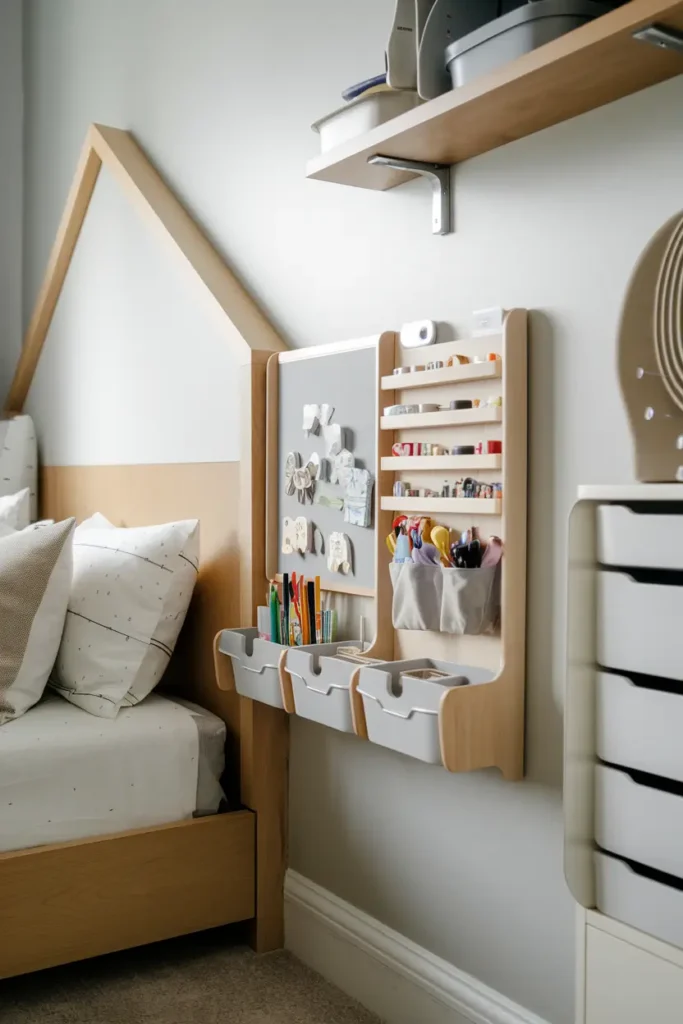
Best for: Children who resist lying still during wind-down time
Pro tip: Rotate activities weekly to maintain novelty. Include puzzle books, sketch pads, and tactile fidget toys that provide sensory input without overstimulation.
Consider this: Position everything within arm’s reach of the bed to avoid the temptation to get up once settled.
6. Growth Chart Gallery Wall
Transform height measurements into an interactive art installation. Use creative themes like a climbing tree, rocket ship, or mountain range where growth literally shows progress toward new adventures.
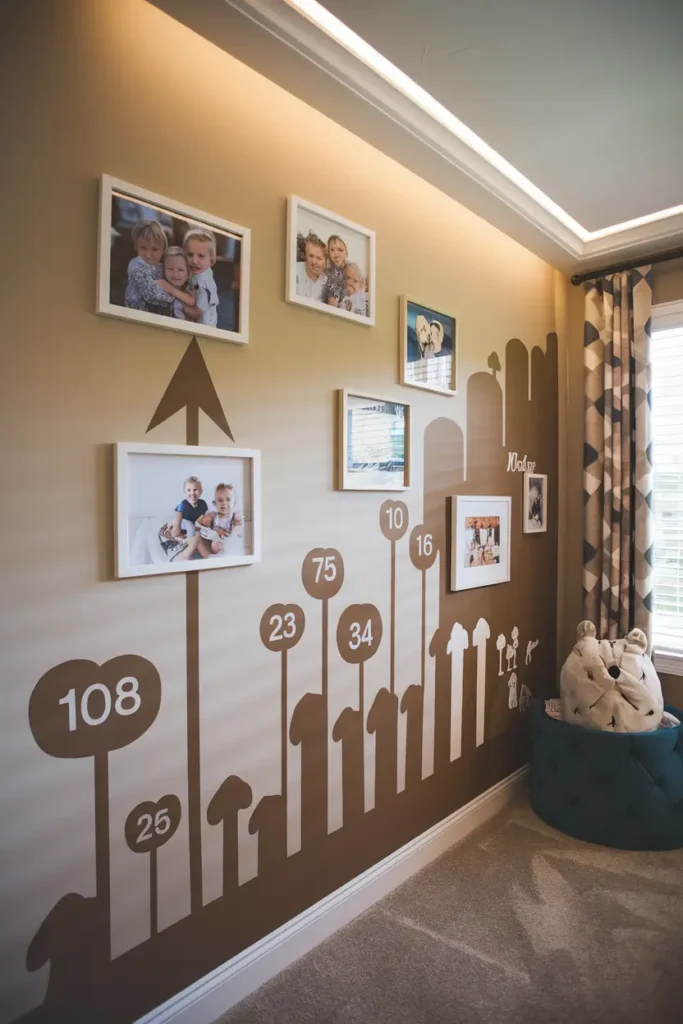
Best for: All ages, but especially meaningful for children going through growth spurts
Pro tip: Add photos at each height marker to create a visual timeline of their development, making bedtime a time for reflecting on how much they’ve grown.
Consider this: Choose a wall that won’t need repainting frequently, and use removable elements for easy updates.
Sensory Comfort Zones for Better Sleep
7. Texture Wonderland Walls
Create tactile experiences using various fabric panels, wooden elements, and safe textured materials at child height. This provides calming sensory input that many children crave before sleep.
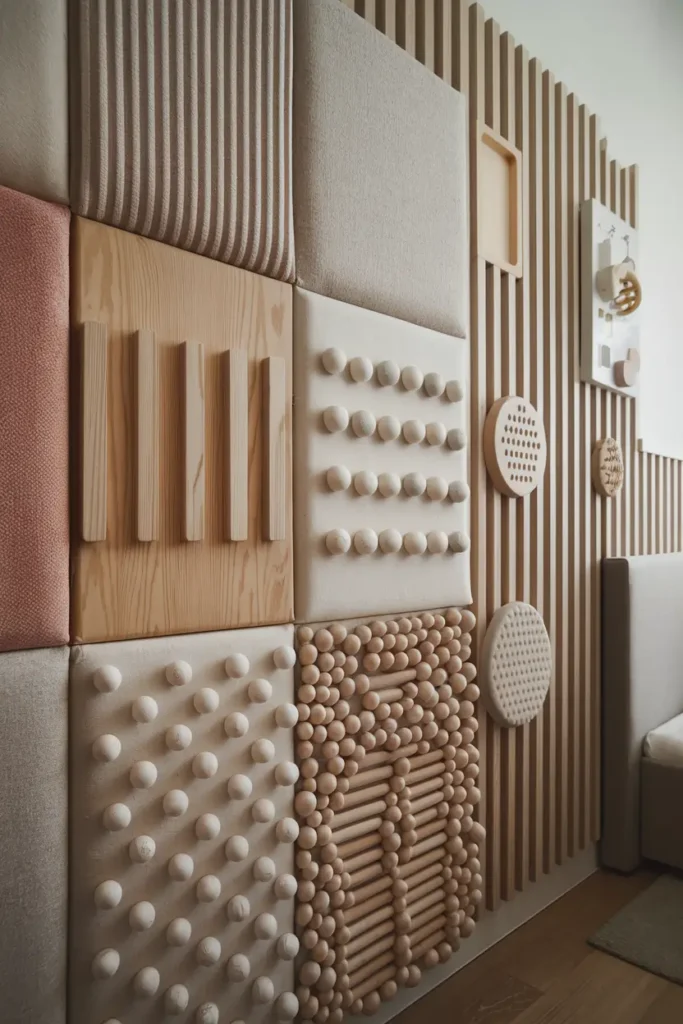
Best for: Children with sensory processing needs or those who benefit from calming touch experiences
Pro tip: Include different textures like smooth wood, soft fur, cool metal, and bumpy fabric arranged in patterns they can trace with their fingers.
Consider this: Regularly clean textured elements and ensure all materials are non-toxic and securely attached.
8. Sound Sanctuary Setup
Design an acoustic environment that promotes relaxation using sound-absorbing materials disguised as decorative elements. Fabric wall panels, thick rugs, and strategic furniture placement can dramatically improve sleep quality.
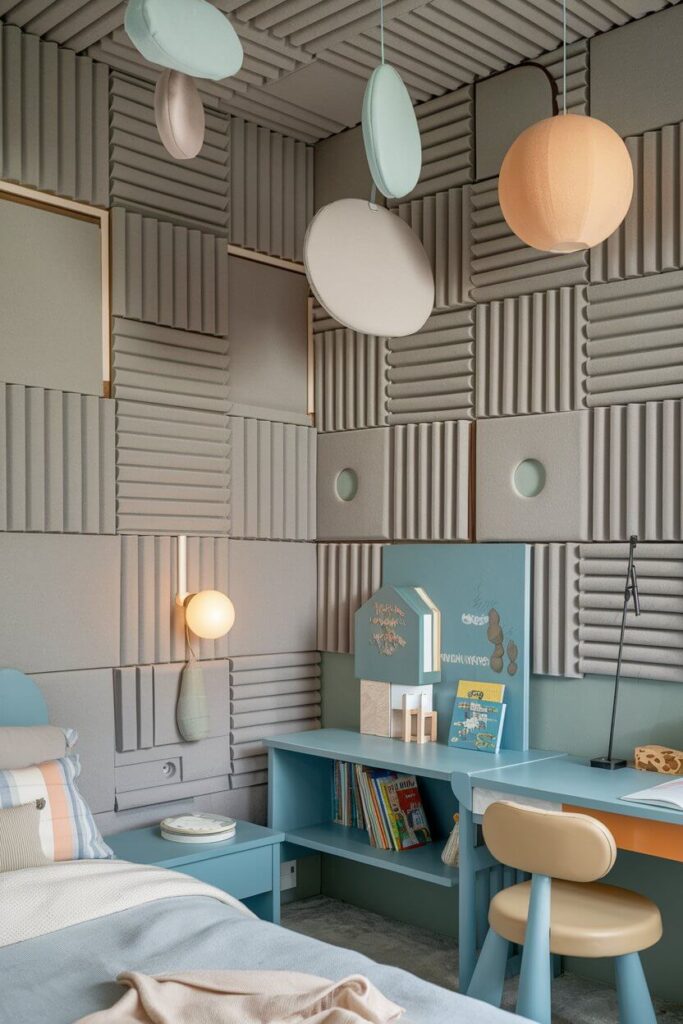
Best for: Light sleepers or children in noisy households
Pro tip: Create a “sound menu” of different white noise options—rain, ocean waves, forest sounds—that children can choose based on their mood.
Consider this: Avoid sounds that might become dependencies; the goal is to enhance natural sleep patterns, not replace them entirely.
9. Temperature Control Command Center
Give children age-appropriate control over their room’s comfort level with accessible fans, weighted blankets of different weights, and breathable bedding options they can adjust independently.
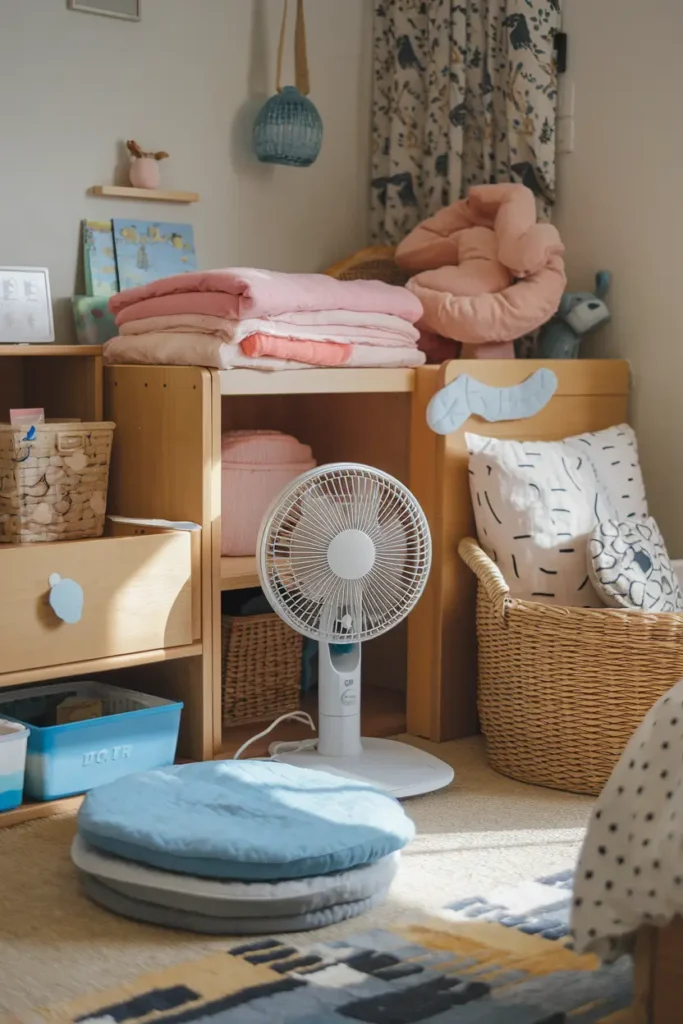
Best for: Children who frequently complain about being too hot or too cold
Pro tip: Teach them to recognize their body’s signals and adjust their environment accordingly, building self-awareness and independence.
Consider this: Safety first—ensure all electrical elements are age-appropriate and properly installed.
Adventure-Themed Transformations
10. Pirate Ship Bedroom
Convert the bed into a ship’s cabin complete with rope ladders, a ship’s wheel, and treasure storage. The key is creating functional elements that serve real purposes while maintaining the theme.
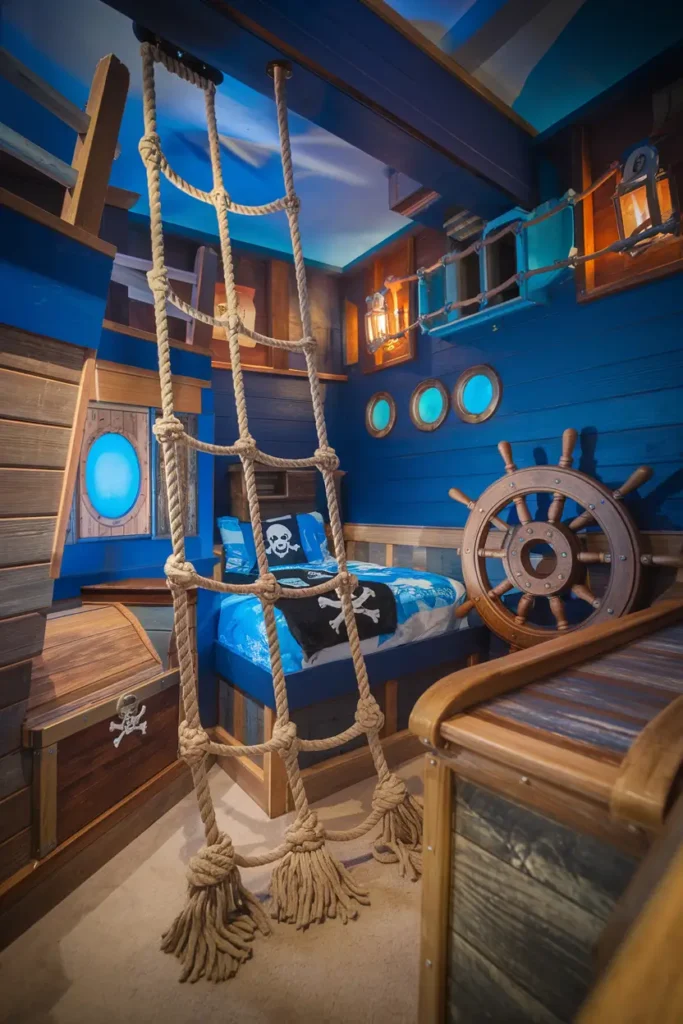
Best for: Children ages 5-10 with active imaginations who love adventure stories
Pro tip: Use the “treasure chest” (a storage ottoman) for bedtime treasures like special stuffed animals or bedtime books, making cleanup part of the adventure.
Consider this: Ensure safety with all rope elements and avoid small pieces that could pose choking hazards for younger siblings.
11. Space Station Headquarters
Transform the room into a spacecraft using metallic elements, control panel wall decals, and LED lighting that mimics spaceship ambiance. Include educational elements about actual space exploration.
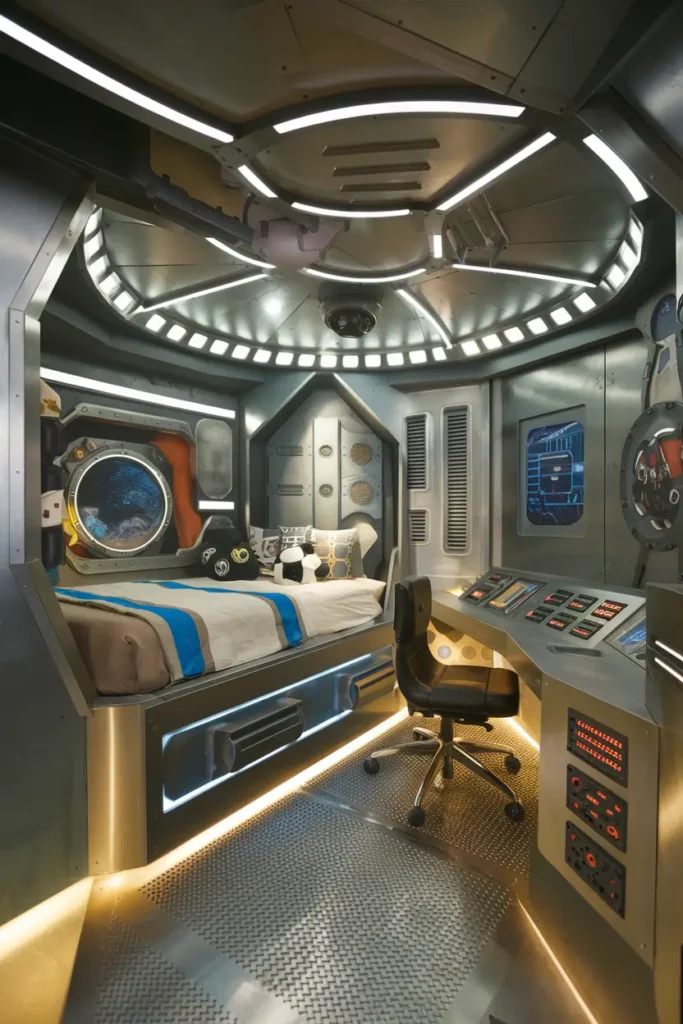
Best for: STEM-minded children who dream of space exploration
Pro tip: Create a “mission log” journal where they can record their daily adventures before bed, turning bedtime into mission debriefing time.
Consider this: Balance excitement with calm—too much stimulation can make it harder to wind down for sleep.
12. Enchanted Forest Retreat
Bring the outdoors inside with tree branch elements, forest creature décor, and natural textures. Use real or realistic artificial plants to create a garden-like atmosphere.
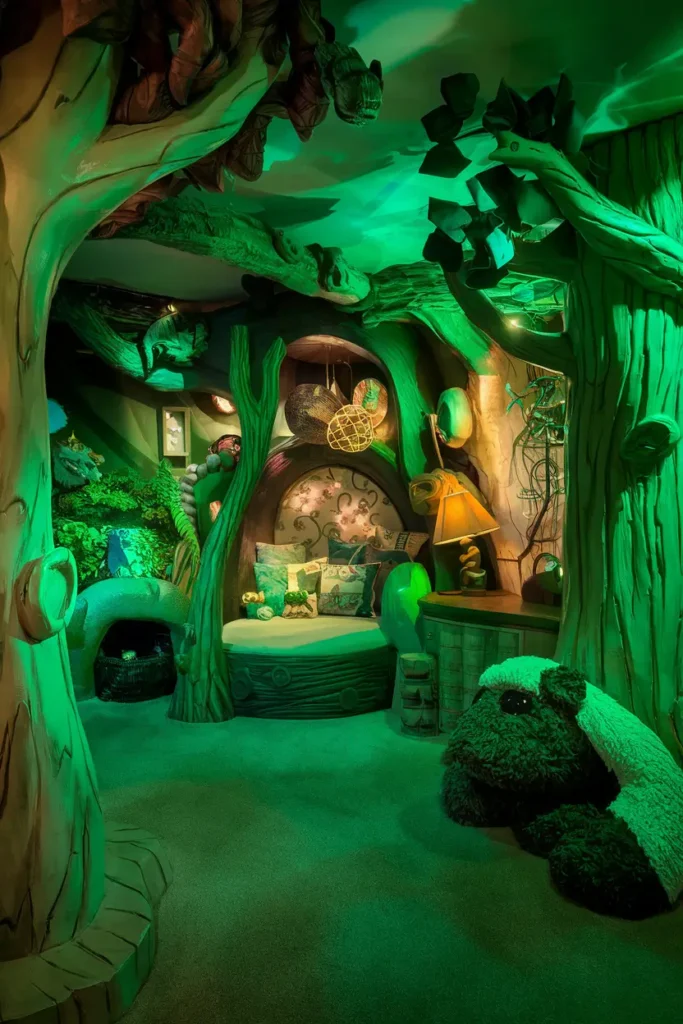
Best for: Nature-loving children who find outdoor environments calming
Pro tip: Include nature sounds and subtle forest scents using natural essential oils to engage multiple senses safely.
Consider this: Maintain plants properly if using real ones, and ensure any artificial elements are high-quality and won’t deteriorate quickly.
Cozy Comfort Maximizers
13. Layered Lighting System
Create multiple lighting options that support different activities and moods. Think task lighting for reading, ambient lighting for relaxation, and night lighting for security.
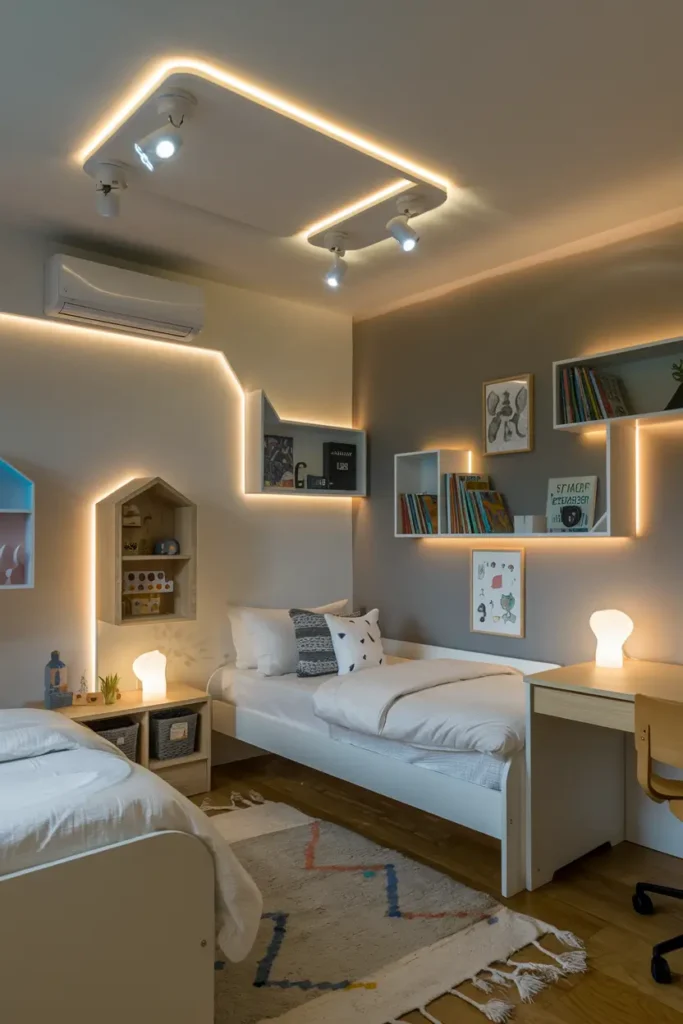
Best for: All children, but especially those who are afraid of the dark
Pro tip: Install dimmer switches and teach children how to adjust lighting for different activities, giving them control over their environment.
Consider this: LED bulbs are safer and more energy-efficient, and warm-toned lighting is more conducive to sleepiness than cool blue tones.
14. Ultimate Comfort Bedding Station
Move beyond basic sheets to create a customizable comfort system. Include options like weighted blankets, cooling pillows, and different fabric textures they can mix and match.
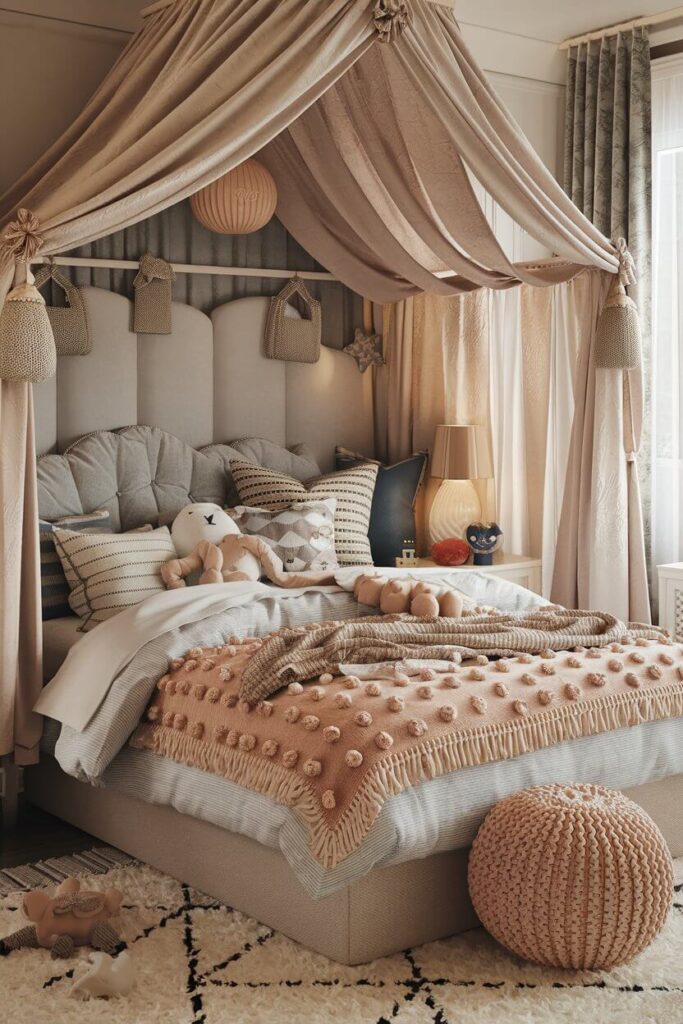
Best for: Children with specific comfort preferences or sensory needs
Pro tip: Create a “bedtime nest” ritual where they arrange their comfort items exactly how they like them, making bedtime preparation enjoyable rather than rushed.
Consider this: Wash bedding regularly and have backup options available for those inevitable middle-of-the-night accidents or spills.
15. Personal Climate Control
Install a small, safe fan and provide various blanket weights so children can create their perfect sleep temperature. Include breathable, moisture-wicking fabrics for year-round comfort.
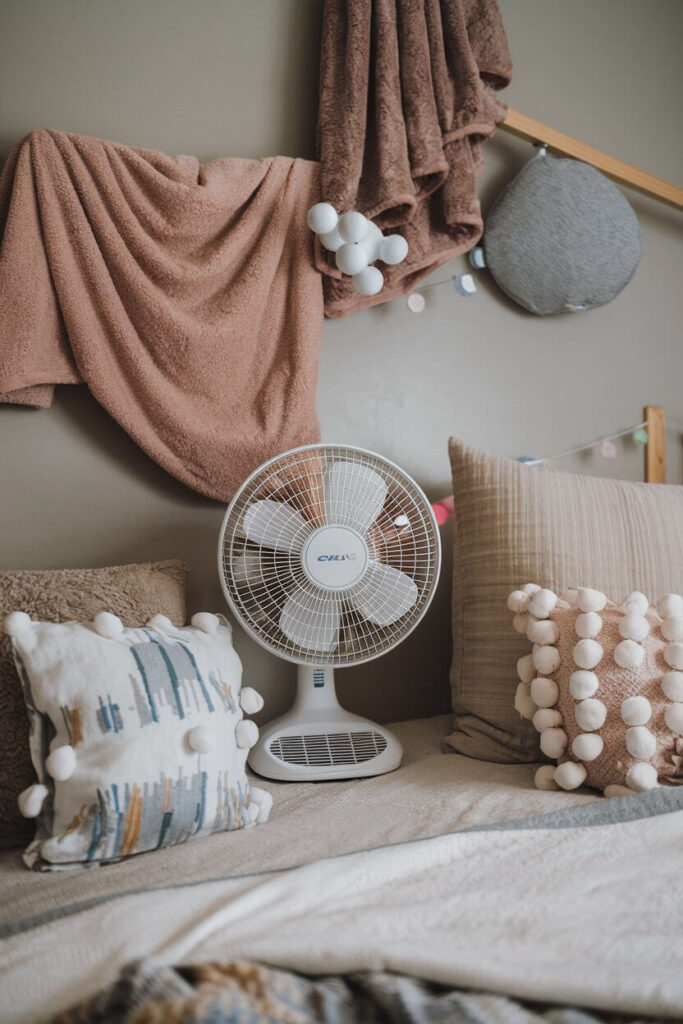
Best for: Children who struggle with temperature regulation during sleep
Pro tip: Teach them to adjust their setup based on seasons and how they’re feeling, building awareness of their body’s needs.
Consider this: Ensure all electrical elements are age-appropriate and positioned safely away from bedding and play areas.
Creative Storage Solutions That Spark Joy
16. Treasure Hunt Organization
Turn cleanup into an adventure by creating themed storage solutions. Pirate chests for toys, rocket ship containers for books, and fairy house cubbies for craft supplies make organizing fun.
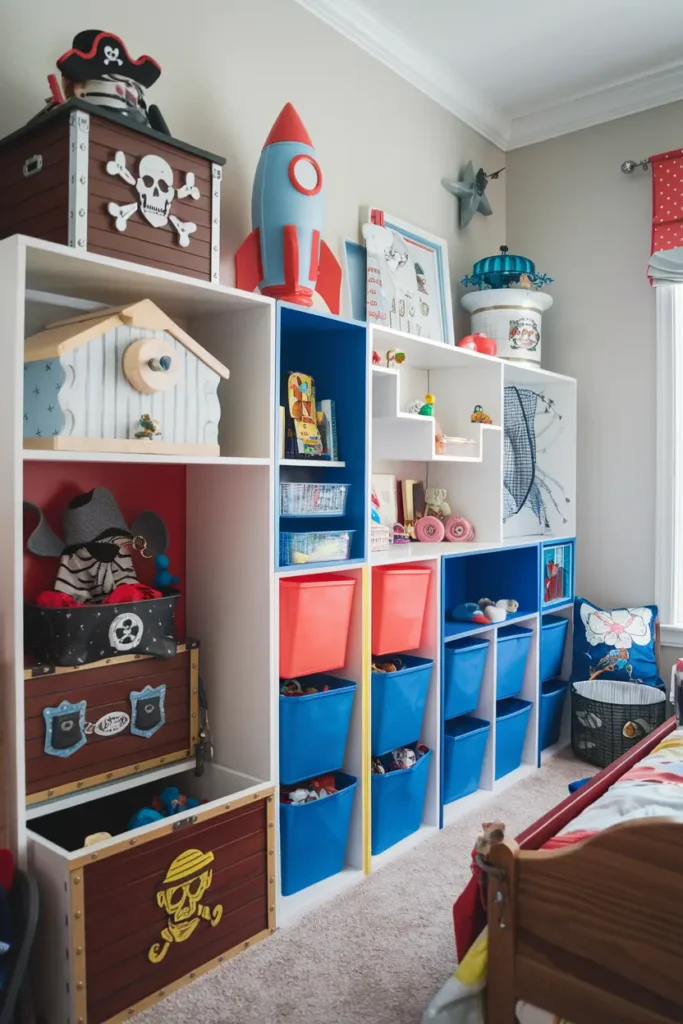
Best for: Children who resist cleanup routines
Pro tip: Label storage containers with pictures and words, making it easy for children to maintain organization independently.
Consider this: Choose storage solutions that grow with the child and can be repurposed as their interests change.
17. Display Gallery for Masterpieces
Create an ever-changing art gallery where children can showcase their creations. Use wire systems, magnetic strips, or bulletin boards that make rotating artwork easy and celebrated.
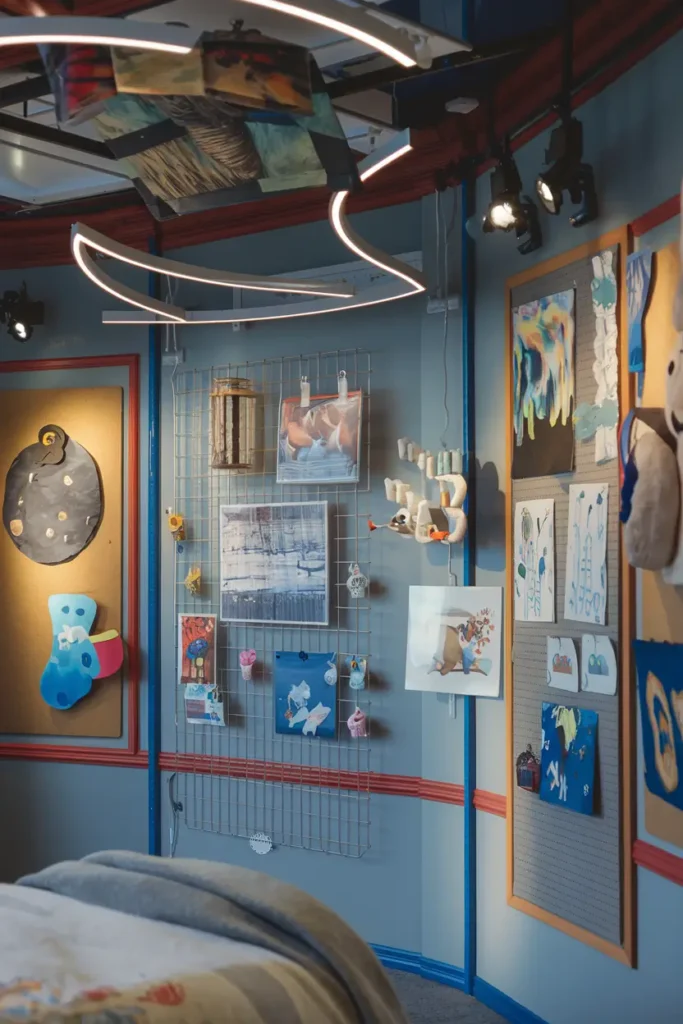
Best for: Creative children who produce lots of artwork and crafts
Pro tip: Establish a “featured artist” system where they choose their favorite pieces to display prominently, building confidence and pride in their space.
Consider this: Protect wall surfaces with appropriate backing materials and choose display methods that won’t damage artwork.
18. Memory Lane Corner
Dedicate space for displaying special mementos, photos, and keepsakes that tell their personal story. Update regularly to reflect their growth and changing interests.
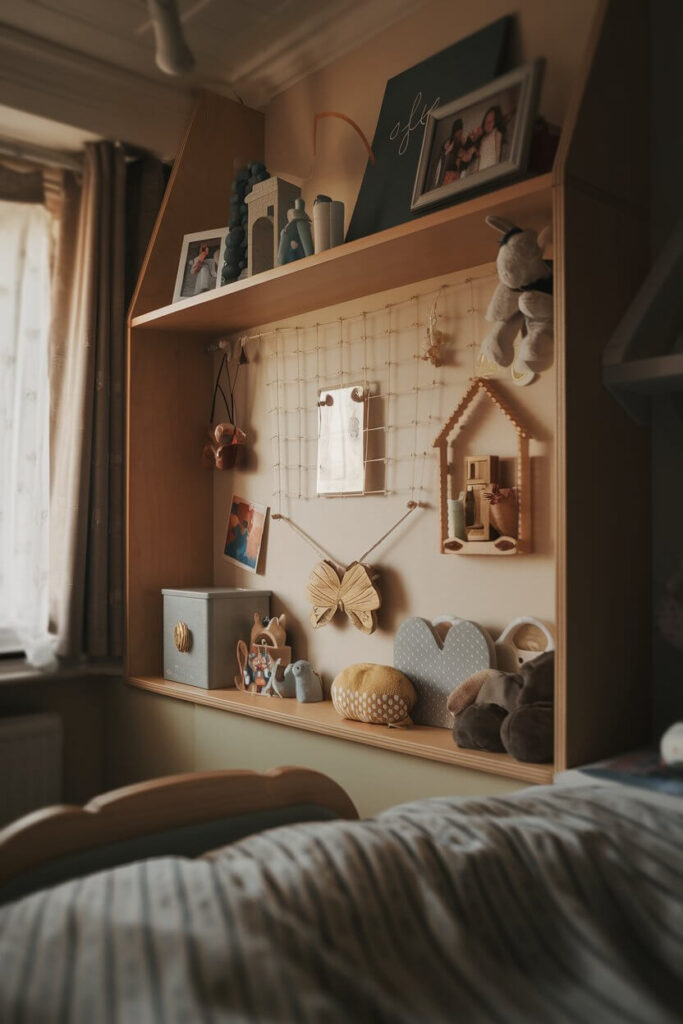
Best for: Children who are sentimental and enjoy reflecting on memories
Pro tip: Include a special box or drawer where they can store items that are too precious for everyday display but important enough to keep close.
Consider this: Respect their choices about what to display and when to update, allowing them ownership over their personal history presentation.
Interactive Entertainment Centers
19. Bedside Activity Command Center
Install wall-mounted organizers at bed level stocked with quiet activities like coloring books, puzzle books, and sensory toys. Everything should be reachable without getting up.
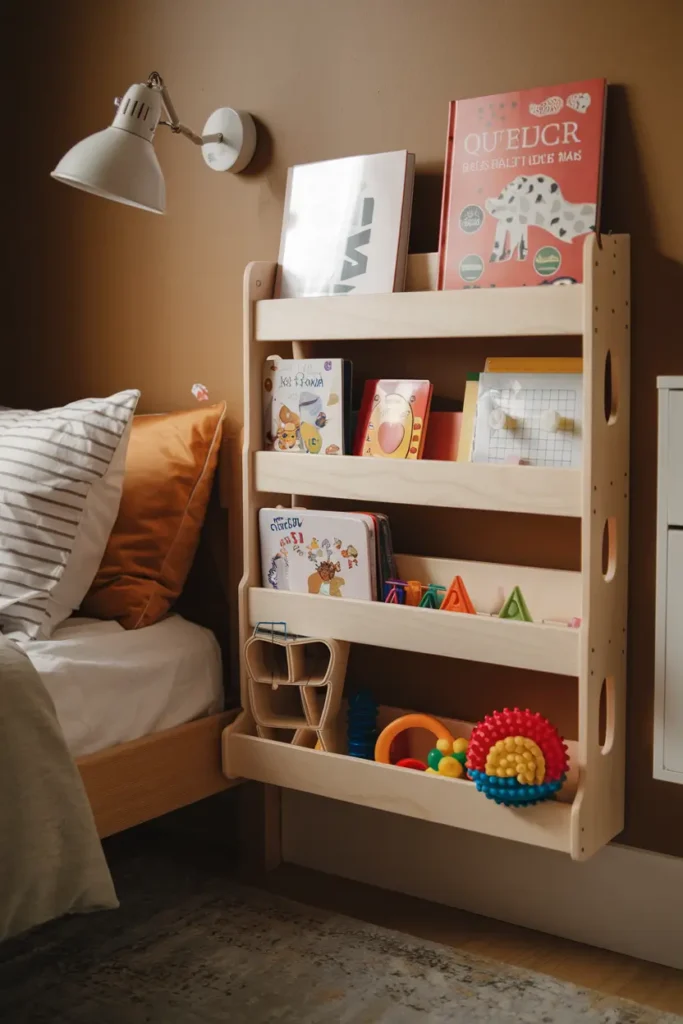
Best for: Children who need transitional activities to settle down for sleep
Pro tip: Rotate contents weekly to maintain interest, and include a small flashlight for late-evening reading without disturbing others.
Consider this: Choose activities that naturally lead to drowsiness rather than increased alertness.
20. Music and Story Station
Create a dedicated area for audio entertainment with child-friendly controls for audiobooks, calming music, and nature sounds. Include comfortable seating for listening sessions.
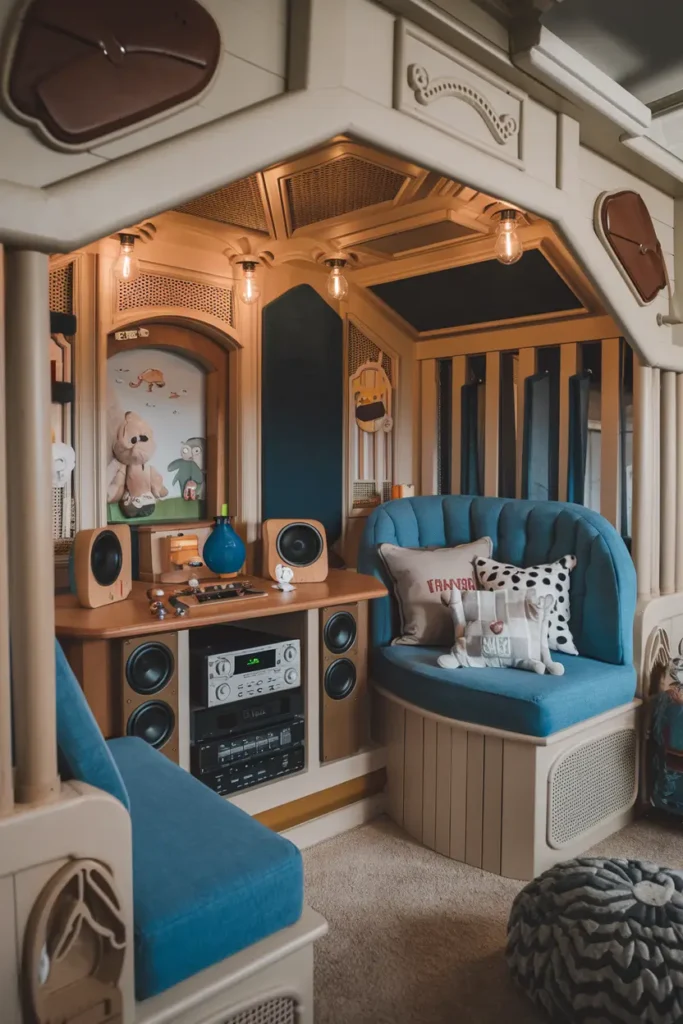
Best for: Auditory learners and children who enjoy stories and music
Pro tip: Develop a bedtime playlist together that gradually becomes slower and quieter, naturally guiding them toward sleep.
Consider this: Use timers to prevent all-night audio playing, and choose content appropriate for bedtime rather than exciting adventure stories.
21. Building and Creation Zone
Designate floor space with proper lighting and storage for construction toys, art supplies, and building materials. Include a comfortable rug for extended play sessions.
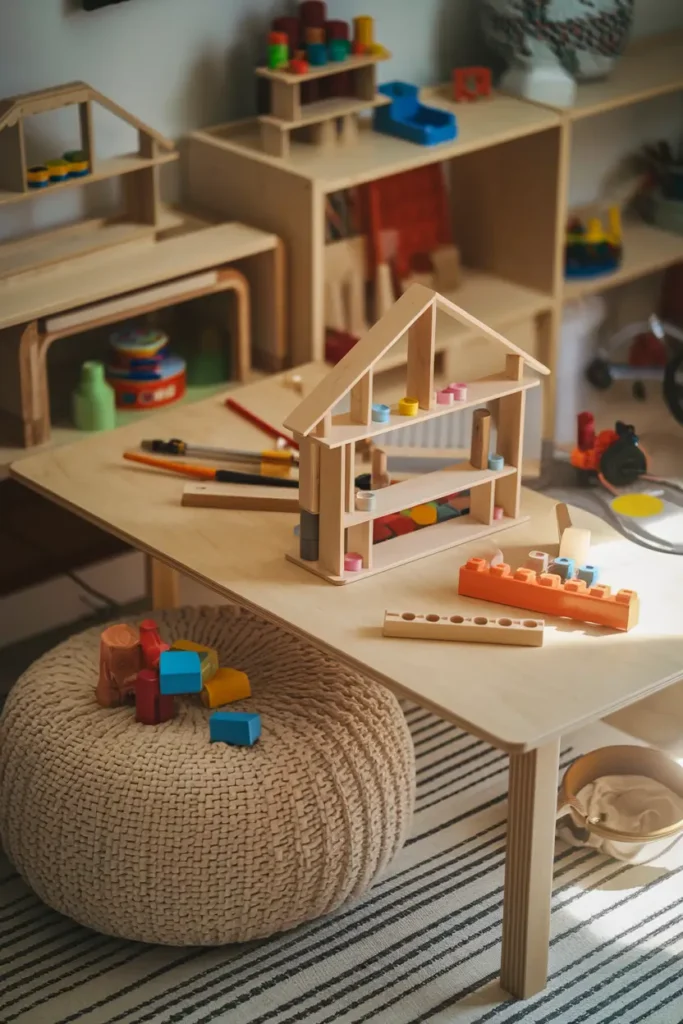
Best for: Hands-on learners who need creative outlets before winding down
Pro tip: Establish a “final creation” rule where they complete one last project before bed, providing satisfaction and closure to the day.
Consider this: Choose building materials that aren’t noisy and won’t disturb other household members during evening play.
Personalization Powerhouses
22. DIY Decoration Workshop
Provide supplies and space for children to create and update their own room decorations. Include removable options like washi tape, repositionable decals, and changeable displays.
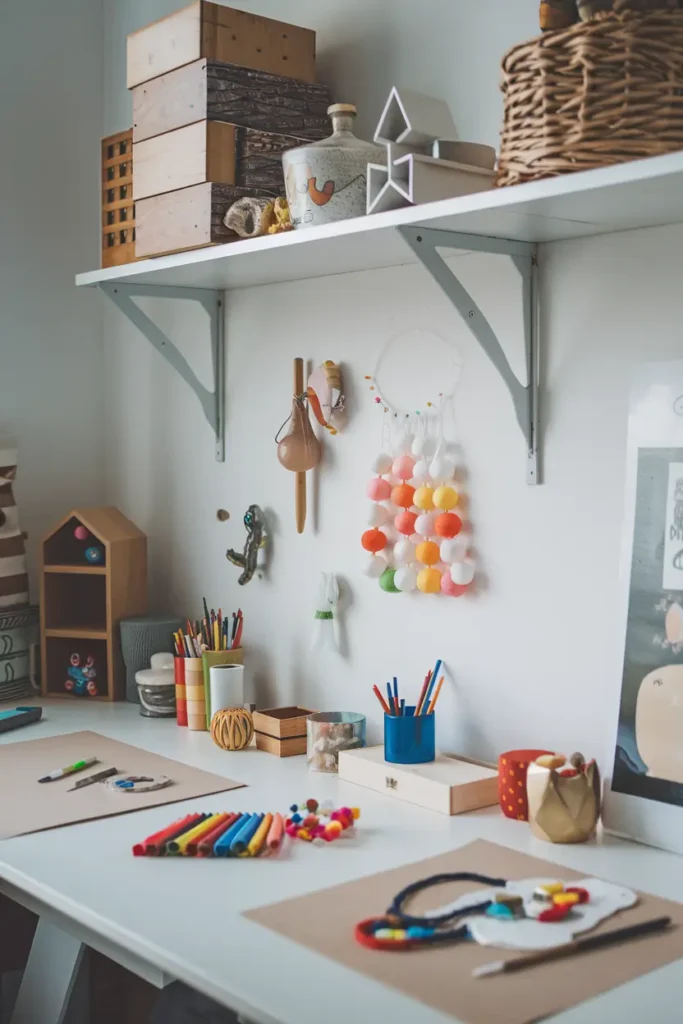
Best for: Independent children who want control over their environment
Pro tip: Schedule monthly “room refresh” sessions where they can update decorations, keeping the space feeling new and exciting.
Consider this: Establish boundaries about what can and cannot be decorated to protect important surfaces while still allowing creative expression.
23. Growth and Goal Visualization Board
Create an interactive display where children can track their progress toward goals, display achievements, and plan future adventures. Make it visually engaging and easily updatable.
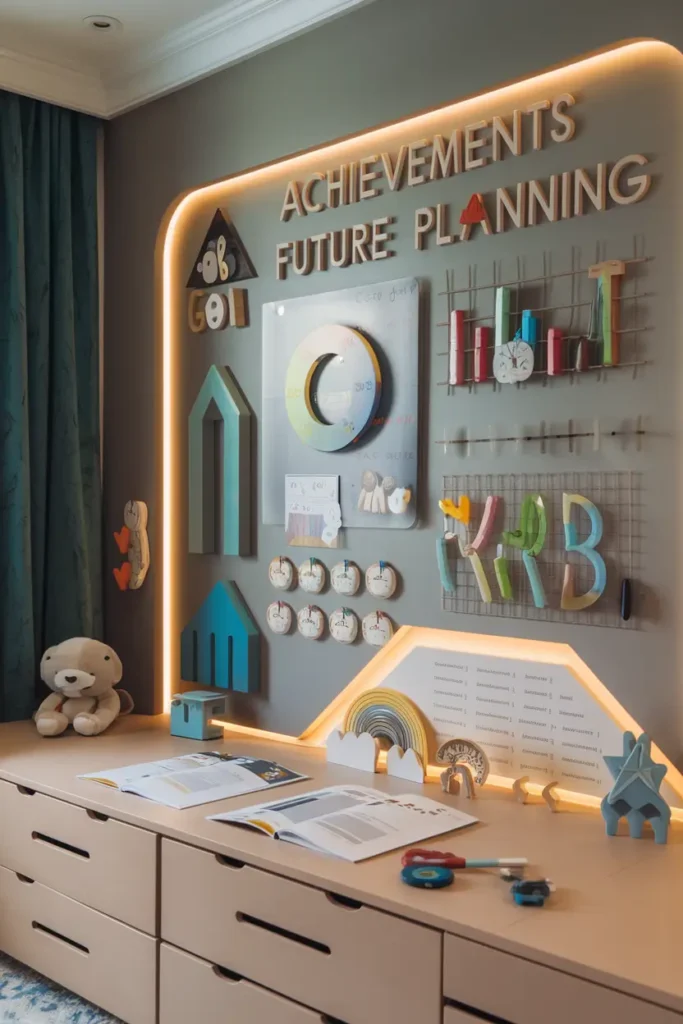
Best for: Goal-oriented children who are motivated by visual progress tracking
Pro tip: Include both short-term daily goals and long-term dreams, helping them see the connection between daily actions and bigger aspirations.
Consider this: Keep goals age-appropriate and achievable to build confidence rather than frustration.
Bringing It All Together: Implementation Strategy
The key to successfully transforming your child’s bedroom isn’t trying to implement every idea at once. Instead, start with 2-3 concepts that most directly address your child’s specific bedtime challenges or interests.
Phase 1: Foundation (Weeks 1-2) Focus on comfort and safety basics—proper lighting, comfortable bedding, and temperature control. These elements form the foundation for everything else.
Phase 2: Personalization (Weeks 3-4) Add elements that reflect your child’s personality and current interests. This is when the room starts feeling uniquely theirs.
Phase 3: Enhancement (Month 2+) Layer in interactive and creative elements that will grow with your child and maintain long-term interest.
Remember, the most successful bedroom transformations happen gradually, allowing children to adjust to and appreciate each new element. The goal isn’t perfection—it’s creating a space where your child feels secure, valued, and excited to spend time.
The Bedtime Transformation Timeline
Week 1: Children typically notice and appreciate the changes but may still follow old bedtime patterns.
Weeks 2-3: New routines begin forming around the enhanced bedroom environment.
Month 1+: Bedtime resistance typically decreases significantly as the room becomes a desired destination rather than a place they’re sent.
3+ Months: The bedroom becomes a true personal sanctuary that supports better sleep quality and independence.
The investment in creating a bedroom your child truly loves pays dividends far beyond easier bedtimes. You’re creating a foundation for healthy sleep habits, independence, and personal expression that will benefit them for years to come.
When children have ownership and pride in their personal space, bedtime stops being a battle and becomes the natural, anticipated end to a full day of adventures. Sweet dreams are made of rooms like these.



